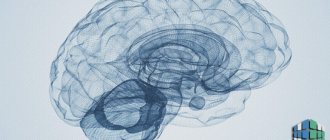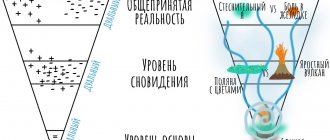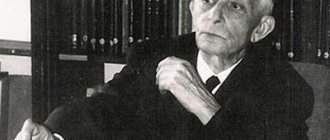| BLJAD! This article is full of love and adoration. Perhaps we should add a little criticism? |
| « | Sometimes I allowed myself, probably, immodest entertainment - I tuned into his mind and began to observe what was happening in the surrounding space through his eyes - and even through the prism of his consciousness. I perceived not only what he saw, but also the voices that were heard in his mind (I will not call them thoughts - since he did not hear half of them himself, and obeyed the other half without thinking). | » |
| — Victor Pelevin. Love for three Zuckerbrins | ||
What is cognitive therapy and how does it work?
Cognitive psychology
- the most modern understanding of science about how Moscow works. Called to finally cut out these Freuds of yours with their damn dreams about fucking. It is based on the idea that mosk is like a computer, only soft and slimy, wetware, as they say. In the sense that the human psyche, like a favorite laptop, stupidly (or surprisingly efficiently) processes one information into another. The concept was created jointly by computer scientists and psychologists.
Content
- 1 A little history, or how Moscow studied Moscow
- 2 The essence of the method 2.1 What is “cognitive”?
- 3.1 Experimental confirmation
- 4.1 Maslow's pyramid
Modern Perspectives
Modern views in cognitive psychology typically view cognition as a dual process theory, outlined by Daniel Kahneman in 2011. Kahneman further differentiated the two processing styles by calling them intuition and reasoning. Intuition (or system 1), like associative reasoning, has been defined as fast and automatic, usually with strong emotional connections included in the reasoning process. Kahneman said that this kind of reasoning is based on formed habits and is very difficult to change or manipulate. Reasoning (or System 2) was slower and more variable because it was subject to conscious judgments and attitudes.
[edit] A little history, or how Moscow studied Moscow
To understand how the psycholunatics and pogromists came to such an innovative (she is only about sixty years old) concept, it is necessary to understand how ideas about the psyche developed before that.
In the dark ages, instead of a psyche, people had a soul, and only G‑d and the Russian Orthodox Church knew what was going on in it. Around the end of the nineteenth century, scientists were somewhat fed up with this state of affairs, and they began to think of something to replace the soul with.
On the one hand, there was Freud with his psychoanalysis, as well as his many followers. “Come on, everyone started delving into themselves!” - Freud exclaimed, and came up with the conscious, unconscious and preconscious. The point was that only the deep and rich inner world of a person is important and meaningful. And this world, bitch, is so deep and rich that even Freud himself and even Allah cannot explain how it works. Nevertheless, Freud did bring some of his patients out of depression into a normal state, and therefore psychoanalysis was recognized as workable and began to be developed.
On the other hand, there were the behaviorists. Under the impression of Pavlov’s dogs, a certain John Watson, not the same as Holmes, but also a doctor, decided that man is the same animal. This means that the behavior of pathetic humans and other rats is based on the “stimulus - erection-response” system. Like if you kicked a bear, the bear ate you. As for the soul and consciousness, they do not exist, “what cannot be measured does not exist.”
The system was excellent in terms of “scientific”, since the stimulus and reactions could be measured by objective means. And even hints in terms of psychotherapy appeared - since a person has behavior, then you just need to train him, like Kuklachev his cats, and everything will be fine with him. Having got their hands on the scientific method, psychologists began conducting experiments on people. Early experiments amaze with their naive cynicism, and cause righteous anger among those who are especially sensitive.
However, there were some problems. Firstly, the “stimulus-response” scheme did not always work in the same way. Animals, and especially humans, could have different reflexes to the same stimuli. Secondly, scientists, willy-nilly, admitted to themselves that in addition to the “S → R” scheme, there was something else in their heads. A little later, neobehaviorists
tried to get out and expanded the model of the human head with the letter V - some intermediate factors that secure the chains S → R. However, even this very V was, at best, a simple multiplier that either strengthens the connection between stimulus and response, or weakens it. Academic psychologists were afraid to put forward more complex ideas about what might be happening inside the head.
Psychotherapists also did not sit idly by; in fact, the entire subsequent history of psychotherapy up to the cognitive scientists was built on Freud’s ideas - that the rich inner world decides. Gestaltists, for example, just populated the consciousness and subconscious with images that a person somehow evaluates and wants to complete, telescientists tried to establish contact with the unconscious through kicking a mortal carcass, and Erich Fromm generally stated that a person is driven by the meanings of life, but that no one knew what to do with it.
The situation was further worsened by the fact that these two directions were in a fierce, frantic fight with each other. In scientific circles, especially American ones, behaviorism continued to rule, ignoring both Freud and the existence of mind/consciousness in general, and in psychotherapy, on the contrary, psychoanalysis and gestalttherapy ruled, and behaviorism was despised.
And then, in this hell and gnashing of teeth, hope appeared.
Scientific background:
1) criticism of behaviorism and the revival of interest in the topic of consciousness in the United States since the 50s of the twentieth century;
2) the influence of Gestalt psychology - the adoption of the active role of the subject, interest in the problem of consciousness;
3) the teachings of J. Piaget, who conducted a number of significant studies on child psychology from the standpoint of studying the stages of a child’s cognitive development;
4) changing the scientific paradigm in physics - abandoning the idea of absolute objectivity and recognizing the active role of the subject in the cognitive process.
[edit] The essence of the method
While psychologists were tinkering with mosk devices, nerds from Britain and America invented computers with computer science. And the nerds decided that this was good. And the nerds set out to measure their strength with G-d himself, creating artificial intelligence.
But then there was an ambush, because as soon as they started, the nerds cried out: “How will we create artificial intelligence if we don’t even know anything about our own intelligence, bida-bida!”
The nerds tried to ask psychologists for advice, but as soon as they looked at the bullshit described above, they lost heart. This would have been the end of the fairy tale, but suddenly one of the nerds came up with what turned out to be a bright thought: “What will happen if the Mosk has to be compared with a computer?”
The nerds sat down with their notebooks and, wow, the picture began to clear up. Let's assume that the brain is an information system. Therefore, it consists of:
- input signals
- permanent memory
- random access memory
- signal conversion algorithms
- and finally the output signals.
Example: you, anonymous, saw a beautiful girl (input signal). A recording of how you jerked off with Sasha Gray was loaded from the permanent memory into the operational memory, and the thought (signal conversion) comes to your mind: “I would fuck her.” But then suddenly (or rather not suddenly, but according to an algorithm, or otherwise a cognitive scheme) another record is loaded from memory - like in the first grade a girl tripped you up. And now you think: “She won’t give it to me,” while making a thinking error (cognitive distortion) of the form: “A general conclusion from a single case.” And then comes the exit signal: you go to the school toilet and jerk off. And in the next booth, your classmate is fucking that same girl, because he has different cognitive patterns in his head. Haha, sucker.
And then, remembering their wonderful school years, the nerds saw that the idea worked and that was good. This, or something like this, is how cognitive psychology began. Catchers of human souls immediately appreciated its advantages:
- Firstly, this approach is understandable to any redneck coder, or to anyone whose computer skills are at least at the level of “emergency computer assistance.” Although no, it will still be a minus.
- First, the subject is consistent with the scientific method ( Newton Issac
, circa 1666
). He has a system-forming theory. It can be measured objectively - by imagining a person as a black box (but with a known general structure) and through this determining what is going on in the skull between stimulus and reflex. Damn, it can even be classified as an exact (and not humanitarian) science, because a person is like an electronic device!
. It would seem that this is a so-so achievement for science - but not for psychology. Before the cognitive approach there is no understandable
general model
the psyche did not exist. Now it exists.
- How reliable it is is a separate question, but that wasn’t the case before.
In general, the cognitive approach affected everyone interested so much that its emergence was later called the “cognitive revolution.” Because he introduced a whole new paradigm of what a person is and how he should be studied/changed.
[edit] What is “cognitive”?
The important thing about all this cognitive farming is that it is not simply the study of human thinking. Cognitive psychology is a view of a person in which he is an information system that processes useful information into garbage (or vice versa). And all functions of the psyche are considered in this direction precisely as various information processors. Thus, CP studies thinking, imagination, attention, perception, memory, emotions, and in general everything that is in the human head - but exactly what from the point of view of information processing by all this hard and software. You can read more here.
Models of attention
There are three models of attention. Early selection by D. Broadbent. Represents a data link limitation. Peculiarities:
- The transmission channel is the central nervous system. Has limited bandwidth.
- Selection occurs in the early stages of sensory analysis.
Processing stages:
- Physical stimuli affect the senses.
- With the help of sensory registration, incoming data is stored in iconic memory.
- Significant information is filtered out using a filter.
- The last stage is the analysis of the selected data.
Late selection by Donald Norman:
- Incoming data is simultaneously identified, processed, and undergoes initial analysis.
- Important information is filtered out.
- The selected data undergoes in-depth analysis. Unnecessary information after processing
- forgotten.
Model of A. M. Treisman:
- Between the verbal analysis of the message and the input sensory signals there is a perceptual filter. Its task is to amplify various signals and filter out unnecessary information.
- When the data passes the filter, the information is divided into separate streams with different activation thresholds.
Data is processed in different ways. There are two methods:
Without concentration, concentration, conscious effort. Automatic processing that occurs in parallel, quickly. Once data is received by the main receptors, it is quickly processed. In this case, the most simple, noticeable signs of objects are highlighted. Focusing attention. Processing takes place sequentially
To do this you need to concentrate your attention and make a conscious effort.
[edit] Cognitive psychotherapy
This is the algorithm, anonymous, that your mosk works.
Born by analogy with the subject. If the brain is a computer, then it has bugs, right? The bugs were called cognitive distortions and hundreds of them were discovered. For example, a person thinks, “The whole world is shit,” and becomes depressed. But is it necessary, on the contrary, to “program yourself to be positive”? A person thinks, “The whole world is candy,” and he also becomes depressed, because the world constantly disappoints him. And these bugs are corrected in the same way as in computers - they are replaced with more adequate settings like: “There is shit in the world, and candy, and even unknown fucking crap.” So that!
The ones about the world-shit and the world-candy. They just fly by so quickly, so SUDDENLY that a person takes them not for bugs, which they essentially are, but for truth, which is true only because it came from within and did not have time to be doubted (plus they are often supported by strong emotions) . “I happen by chance” at its best.
Another important difference between cognitive psychotherapy and other areas is that the psychotherapist has a clear work algorithm for each session. Which is downright blasphemy compared to classical psychoanalysis, where the therapist could rely only on the hazy ideas of the luminaries about the unconscious and his own intuition.
The founders of this direction specifically in psychotherapy are Albert Ellis (rational-emotive-behavioral therapy) and Aaron Beck (cognitive-behavioral therapy). Despite the different names, both write almost the same thing. Ellis is closer to the “common people”, Beck to formal psychiatry. For better understanding, it is recommended to read both. Tellingly, in 1991, Ellis and Beck were recognized, respectively, as the first and third psychologists in terms of influence on humanity (the second was the humanist Carl Rogers). Freud was not included in the top three, although back in 1982 he was in third place. What does it symbolize?
If we draw analogies with the exact sciences, then:
- Freud proposed a “plumbing” model of the psyche - like mental processes put pressure on a person, and all he can do is release them through more socially acceptable channels. Otherwise it will break.
- Then the Gestaltists came and proposed an “electrical” model of the psyche - they say, in the psyche there are charges of inadequacy, which must be completely discharged so that the inadequacy goes away.
- And then cognitivists came and proposed a “computer” model of the psyche - thinking processes information, and if it processes it “inadequately,” then behavior becomes inadequate, therefore, it is necessary to replace inadequate processing methods with adequate ones, teach them to think sensibly.
What will happen next? Probably a smartphone man. Or a Vovan man. So it goes.
- “The brain of smartphone neurons” is a reality: brain neurons require power, and therefore these neurons get tired of doing one thing all the time. The Southern Italian “leisurely” lifestyle SUDDENLY consists of this: people who drive home for lunch, giving Americans a break from the pattern, and do not rush back and forth with sandwiches “like everyone else”, in fact work in the office the same number of working hours as and that's it - people stupidly stay late.
[edit] Experimental confirmation
Main article
:
Cognitive Psychology/Psychological Experiments
Typical Cognitive Therapist
Cognitive psychotherapy has been repeatedly tested experimentally, with fairly good positive results.
Before this, we learned about the human psyche either from self-observation or from observing patients. Therefore, a person in old models turned out to be either deep-thinking or half-crazed.
Cognitive psychology has taken up the task of conducting experiments on mere mortals. And before the ethics commission got to them, they managed to get all sorts of interesting results.
[edit] Down with the unconscious!
One of the undoubted advantages of cognitive psychotherapy is getting rid of the concept of the unconscious introduced by Freud. In short, Freud believed this:
- There is an unconscious - an unknown fucking thing in the depths of the psyche, which no one knows for certain, including the patient himself.
- All psychological problems are located precisely in this very unconscious.
- With the help of shamanic dances with couches and drawings, you can still find out what is going on in this very unconscious and even correct the bugs inside it.
And cognitive psychotherapists began to think like this:
- The unconscious either does not exist, or it does exist, but does not interest us.
- All psychological problems are in mind
. They look like “automatic thoughts”—certain thoughts that quickly pass through a patient’s head and influence his behavior. A person usually does not pay attention to them, but if he does, he will easily detect them. - By noticing and rationally criticizing your automatic thoughts, a person can correct his bugs.
That is, instead of unknown fucking bullshit and shamanic dances, quite obvious (at least for the person himself) mental phenomena appeared, which are easy to detect and easy to change. Epic win!
At the same time, in this way the foundation was knocked out from under the feet of various schizoterics with their “magical power of the unconscious.” Which is also a win. And recent experiments have given philosophers food for thought.
Practical use:
1) Cognitive psychotherapy is a psychotherapeutic method developed by A.T. Bekomi based on developing optimal assessment and self-assessment techniques. The basis of this method is the assertion that cognition is the main determinant of the emergence of certain emotions, which in turn determine the meaning of holistic behavior. At the same time, the occurrence of mental disorders (initially depressive states) was explained primarily due to incorrectly constructed self-knowledge. The procedure of this method includes three stages. At the stage of logical analysis, the patient receives criteria for detecting errors of judgment that arise in affectogenic situations; at the stage of empirical analysis - works out techniques for correlating elements of an objective situation; at the stage of pragmatic analysis - builds optimal awareness of one’s own actions.
2) Rational Emotive Behavior Therapy (REBT) is an active-directive, educational, structured, multimodal approach to psychotherapy and psychological counseling, focused on the problem, created by A. Ellis in 1955 and considering as the main cause of mental disorders are erroneous, irrational cognitive attitudes (beliefs, beliefs, ideas, assumptions, etc.), and not the past experience of the individual (unlike psychoanalysis).
Such cognitions in REBT terms are called “irrational beliefs” (sometimes “irrational beliefs”) and the main goal of therapy is to eliminate them.
Cognitive psychology is actively developing and is far from complete, has all the signs of a scientific school and has become part of the mainstream of psychological thought.
[edit] Memes
Oddly enough, some of the cognitive concepts have already become memes, although their users are not aware of it.
[edit] Maslow's pyramid
Nuff said.
[edit] Rule 7 ± 2
A person can hold so many elements of thinking in his head at the same time. The rule arose from the fact that if the brain is similar to a computer, then its power, like the computer, should be limited. In working memory, for example, a person can hold from five to nine concepts, no more. That’s why it’s advisable to write down your thoughts and call this process a note - otherwise there won’t be enough memory for truly complex thinking.
By the way, cognitive distortions, automatic thoughts and other stereotypical thinking come from the same limitations. Since there are not enough brain resources to think fully at every moment of time, a person forms ready-made templates, and then follows them. Stupid? But it works quickly!
[edit] Cognitive dissonance
Main article
:
Cognitive dissonance
Nuff said. For details, see the related article.
[edit] Cognitive distortions
Main article
:
Cognitive psychology/Cognitive distortions
Evolutionary features of the brain, cockroaches in the head. Available in 100% of the population, in 95% of cases they lead to cognitive dissonance, neuroses, poor sleep, loss of money and time, and other manifestations of FGM, the causes of which are. ChSKh do not lead to breaks in patterns; on the contrary, they strengthen illusions in every possible way, being reinforcement in their titanium-concrete structure. They have enormous practical significance - in particular, for those who have chosen the path of “relatively honest taking of money from the population”: both by criminal scammers and corporations through marketing, advertising and public relations. Invented by cognitive psychotherapists.
In a little more detail, cognitive distortions (or cognitive errors) are systematic errors in thinking, due to which many thoughts, judgments, conclusions that are born in a continuous stream in our brain seem to be infallibly true, but upon objective verification they turn out to be completely false. At the same time, a person himself can be confident in his judgments for many years, because the principle of operation of most cognitive errors becomes clear only when seeing the results of ingenious scientific experiments involving large groups of subjects. Moreover, just being aware of the presence of a particular cognitive distortion does not mean that you are no longer susceptible to it, because cognitive distortions are part of the natural processes of thinking. Everyone is susceptible to all of them, but those cognitive distortions that you do know how they work are usually easily detected when analyzing automatic thoughts, your own or others' reasoning. This is very similar to optical illusions, which you actually can’t stop seeing even if you know what the trick is, but if you still look at it from a different angle or use a ruler, then everything becomes clear.
Scientists have already identified, proven and documented hundreds of such constantly occurring mistakes, and the horizon in this work is not yet visible. Their current complete list is collected on a special page on Wikipedia (the English version is updated more often). And here is a small selection of the most lulz memes:
[edit] Language prime
Meme from the field of psycholinguistics
, invented by Korzybski. Psycholinguistics states that language, the words used in particular, influence thinking processes and the psyche. Therefore, a special language is needed - devoid of the concept “is”. That is, according to the rules of the prime language, you can’t say “You’re a dick,” you have to say, “You did crap,” or, even better, “I rate what you did as crap.” So, they say, it turns out more accurately and constructively, since it eliminates some of the distortion (and causes less butthurt).
[edit] Brain plasticity
Information from a doctor named Taub, who in the second half of the 20th century ran a private clinic for the rehabilitation of people who had suffered a stroke; as a meme popularized by Norman Doidge.
- The essence from Taub is this: the cerebral cortex is not a computer with a strict division of blocks (a la the IBM PC), but rather resembles an Amiga analogue capable of reflashing itself under circumstances (in the sense, with a bunch of coprocessors): disabling one piece of the brain with a stroke, even if can lead to an ass due to the failure of what this piece was supposed to do, but due to the correct jerking off of the brain lobes adjacent to the affected one to the point of being cut off, this is very much fixed. For example, with classes that “trivially” teach a paralyzed person to crawl => walk => run like a kindergartener. In other words, after a stroke, if you don’t forget how to breathe, there is a chance to return everything to the way it was, and still, due to the efficiency of the rest of the brain, doing everything as it was is still possible many times faster than with a kindergartener (if the patient is not a philoniac, does not take days off , and in order to quickly achieve the “Monday effect” he fucks without rest, and the doctor is not a “killer”). In the case of a piece of the brain responsible for complex shit like speech being fucked up, you will have to learn more cunningly (if Broca’s area or Wernicke’s area is affected). ChSH, it was precisely this aforementioned “teaching again, like a baby” that Taub turned out to be simply a breakthrough in how effective,
compared to the “doctor’s decision” of the 1930s, to take and put on crutches a person who had lost precisely the contact of the legs with the brain from a stroke, and not the nerves themselves in legs.
pumped patient, you can find that the fucked-up piece of the brain, although it remains fragmented/filled with stagnant blood, is now being replaced by the neurons in the neighborhood doing the job properly.
- And in “Emperor's New Mind” from Roger Penrose, who in his research refers to Lawrence Weiskrantz, is described as a man who lost his sight due to the reason “it was necessary to remove part of the visual cortex of the brain” ( spoiler:
it’s an aneurysm, or epilepsy
)
, an almost 100% ability was revealed to “guess” which of the figures was being shown to him.
From Norman Doidge the gist is this:
- If you were born with only one hemisphere of the cerebral cortex, then you can go and become a normal person with a job and a license to drive a car (spoiler:
not without mistakes like 100,500 scratches and chips on it from any curb, but with a perk (somehow “in five seconds you can guess what day of the week was on such and such a date decades ago”)
,
and you’ll only get to the doctor for a head scan by accident. - If you fap a lot on pron, then due to the exploitation of the same neural circuits, various kinds of fetishes and more will come and go. Insomnia for “vanilla sex” is treated SUDDENLY with a nofapophone.
- In cases of hardcore BDSM fetishes of specific patients, there is a clear connection with rickets and the corresponding hospital childhood.
Already different
Taub, already in 2007, reported an interesting cool story with pictures: a man gradually lost his brain from the inside and nevertheless lived a full life until the age of 44 in the role of a “civil servant”, which seems to hint at how much mosca people still use . And there is only one solution: the hydrocephalus, seeing an improvement, removed the mounted injection in the head (the same one, IRL, aka “drainage”), which is why the intracranial fluid was quietly putting pressure on the brain for as many as 30 years.
[edit] Weighting coefficients @ Neural network
The parameter for the strength of connection between one neuron and another varies from 0 to 0, (9). Explains the main difference between the brain and the anon’s bakery: in the brain there simply cannot be a binary number system in the form of one signal taken as a threshold signal (that is, as a standard “one” signal, the absence of which gives an even zero), all signals from the neuron to the strength of a neuron changes back and forth, which depends on a ton of reasons (the throughput of the membrane between neurons, the state of the neurons themselves, the respawn of neurons).
- This, ChSKH, was implemented in several places at once. Available:
- The power of the outgoing signal (the same for everyone, this is a neuron: it has one output channel IRL);
- The power of the incoming signal (depends on the size of the specific small process of the receiver neuron with which it is connected to the transmitter signal, or more precisely, on the number of molecules connecting their contact);
- General excitability of the neuron.
- Etc. - salt balance, surrounding magnetic background (MagStim developers guarantee this), etc.
The topic of neural networks itself is a meme of the scientific world and a developing branch of computer science and startups, since it qualitatively contrasts itself with canonical computers with a certain number of digits in the number system. In the “neural network capable of self-learning” version, which effectively imitates something living, the oche neuron is costly to implement even on the most powerful supercomputers, but 20-30 “neurons” in a combination called a “single-layer neural network” can stun those who like to recognize letters of random fonts or even take out those who are ready to analyze the foreign exchange market at their own game.
- But no one forbids creating the so-called. “optical systems” or abandon the idea of a centralized CPU and use parallel computing already on video cards (where each neuron easily gets its own coprocessor; in the “multilayer neural network” version this is implemented with a bang), which makes it easy to tinker with image recognition and other goodies, difficult to implement on ordinary computers, but which are so familiar to the human eye.
[edit] Synergy
Synergy is when, in the presence of each other, while remaining themselves, two substances or even two organizations (and, of course, two parts of the brain), themselves failing and considered “soft,” SUDDENLY with their power in the presence of each other create a particularly strong action in the body\prove to be a powerful player.
In more detail, the essence of synergy is that “sometimes you don’t need to hit just one point, even with the fastest, decisive blow.”
In the case described above with two drugs, for some desired effect it may be necessary to act on two fronts (and then substance A affects the “alpha” receptors, substance B affects the “beta” receptors, and the desired effect is achieved only by simulating some complex state when both “alpha” and “beta” are involved). Or if you need to effectively deal with a disease, then A suppresses the reproduction of the source of the disease, while B normally ruins the life of this source, reducing it to zero against the background of A).
Qualitative characteristics of thinking
Thinking, like other human cognitive processes, has a number of specific qualities. These qualities are present to varying degrees in different people, and are important to varying degrees in solving different problem situations. Some of these qualities are more significant when solving theoretical problems, while others are more significant when solving practical issues.
Examples of qualities (properties) of thinking:
Quick thinking - the ability to find the right solutions under time pressure
Flexibility of thinking - the ability to change the intended plan of action when the situation changes or the criteria for the right decision change
Depth of thinking - the degree of penetration into the essence of the phenomenon being studied, the ability to identify significant logical connections between the components of the problem
[edit] Cognitive psychology vs NLP and other bullshit
| « | A rat comes to a white mouse and asks: “Well, listen, we are almost no different. But people care about you, and they are trying to kill me.” The white mouse replies: “Now do you understand how important PR is?” | » |
| — Anecdote | ||
Actually, approximately the same thing happened with cognitive psychology and NLP. If the first is real science with scientists, research and experiments, then the second is semi-esoteric voodoo, aimed exclusively at gestalt gesheft. Although the ideas are basically similar.
The biggest problem with NLP is the lack of a theoretical basis. Well, that is, in general. There is something vague about the meta-model and submodalities. But how exactly it works, and how it is connected to specific techniques, no one knows. And no one needs to know this, because NLP sells perfectly as it is.
And cognitive psychology is a boring science with boring books and slightly less boring Wikipedia articles. In addition, the literature on cognitive psychology is mostly American, and either it has not been translated here, or it has been translated in such a way that it’s better not to. By the way, it’s the same with NLP - but NLP promises you to hypnotize all the women and become millionaires in a week, and therefore makes a profit, even if the trainer has only read the primer of all the books in his life.
In short, if you want to know how Moscow works, read real psychologists. And if you want to quickly raise money, organize NLP trainings, lol.
Somewhere not far from the subject there is also “Synton” with its “positive thinking”. For reference: positive thinking is a pure cognitive distortion. However, Sinton’s website also contains literature on cognitive psychology - so the mutually exclusive paragraphs are observed.
Modern Perspectives
Contemporary views of cognitive psychology typically view cognition as a dual process theory outlined by Daniel Kahneman in 2011. Kahneman distinguished more between the two processing styles, calling them intuition and reasoning. Intuition (or system 1), similar to associative thinking, has been defined as fast and automatic, usually with strong emotional connections included in the thinking process. Kahneman said that this kind of reasoning is based on established habits and is very difficult to change or manipulate. Reasoning (or System 2) was slower and much more variable, being subject to conscious judgments and views.
[edit] Links
- We don't notice how much we don't notice - a satisfying interview with a cognitive psychologist.
- Cognitive therapy. A complete guide to fighting your cockroaches. The author is Judith Beck, daughter of Aaron Beck, one of the founders of the cognitive movement in psychotherapy.
- Psychotraining according to the Albert Ellis method is a book by another founder of the cognitive direction in psychotherapy. Written specifically for the average reader, without any confusion, you will even understand.
- Good science on the topic
| [ + ] Cognitive psychology is a healing panacea for all diseases | |||||||||||||||
| |||||||||||||||
| [ + ] Cognitive psychology Matan | |||||||||||||||
| |||||||||||||||
Mental operations
The thinking process includes several operations: comparison, analysis, synthesis, abstraction, generalization, specification.
Analysis
- mental division of an object into its constituent elements with their subsequent comparison. For example, a psychologist analyzes the personal qualities of his client based on the results of the Cattell test.
Synthesis
- combining individual components into a whole. Usually adjacent to analysis. Continuing the previous example, let us imagine how a psychologist, after analyzing several tests, builds a generalized psychological portrait of a person.
Abstraction
- highlighting one side of an object or phenomenon that in reality does not exist as a separate side. As a result of abstraction, concepts are formed. As an example, we can take the concept of “reliability”, as a low probability of breakdown of some type of household appliance.
Generalization
— highlighting common essential properties in compared objects. For example, after analyzing sales of individual types of bread, the owner of a bakery comes to the conclusion that butter buns are in best demand, regardless of their size and fillings.
Specification
- an operation inverse to generalization, the identification of characteristics of an object or phenomenon that are characteristic of it, not related to the features common to the class of the object or phenomenon. For example, the owner of a mini-bakery, having discovered the increased demand for buns, decides to bake them a new type - with sesame seeds and strawberry filling.
Examples of similar educational works
Human psychology
... a person, upon awakening, is filled with simple ideas, begins to think, that is, to form complex ideas. Locke introduced into the language of psychology the concept of... mental processes (from perception to thinking inclusive) as the orienting activity of the subject in...
Human Psychology 4
... thinking. For example, monkeys are characterized by mental activity that is more complex than that of other animals. This stage of the psyche is called the stage of intelligence. Combining all of the listed stages of a person’s psyche…to everyone—everything carries information about everything. This …
HUMAN PSYCHOLOGY 5
... were guided by the fact that classes in the course “Human Psychology” should contribute to the conscious assimilation of the theoretical foundations of modern ... lesson No. 14 Topic “attention” Plan: The concept of attention. Basic types of attention. Characteristics of properties...
Human Psychology in Islam
...not to mention the basic tenets of faith. So, let's look at human psychology in Islam. 1. Being with Allah. And when... a real Muslim. Prayer in Islam is inextricably linked with such a concept as tawhid, that is, consubstantial with Allah. She reflects...
Post-non-classical human psychology
... the creation of a special discipline - psychological anthropology, which studies human psychology in its specifics [4: p. 32-33]. ... co-existential community. The fundamental status of the concept of “co-existential community of people” as a special space where ...











